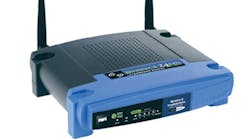This app note is part of the TechXchange: Device-Level Antenna Selection Considerations.
Antennas are a critical component in any wireless system. To design an antenna for wireless local-area-networks (WLANs), one of several techniques can be implemented. A printed-circuit-board (PCB) antenna is one type that can be used for these applications. In a six-page application note titled “Design and Simulation of a 2.4 GHz/5.6 GHz WLAN Antenna on PCB Technology,” National Instruments provides a description of the design and simulation of PCB antennas for WLAN applications using the NI AWR Design Environment software. The application note describes a 2.45 GHz single-band antenna as well as a dual-band antenna intended for use at 2.45 and 5.6 GHz.
The application note begins by describing the planar inverted-F antenna (PIFA) shape, which is the basis for the design examples. The first example described is a single-band antenna intended for use at 2.45 GHz. The application note demonstrates the software’s capability to fine-tune the antenna to achieve desirable results at the 2.45 GHz target frequency. The simulated results for the antenna’s gain and directivity are presented.
The layout of the single-band antenna is then modified to create a dual-band antenna. A second radiator element is added, and approximate radiator lengths for 2.45 and 5.6 GHz are applied. The application note again demonstrates the tuning performed by the software to achieved the desired results at the target frequencies of 2.45 and 5.6 GHz. Simulation results of the dual-band antenna are presented.
The final step analyzed the antenna’s sensitivity to PCB material tolerances. FR4, which is the PCB material used to design the antenna, has a dielectric constant ranging from 4.0 to 4.9. The original simulations were performed with the dielectric constant’s value set to 4.47. To demonstrate the amount of resonance shifting as the dielectric constant changes, additional simulations were performed with the dielectric constant set to both 4.2 and 4.9. The results obtained from this final analysis can determine, depending on the actual requirements, if a PCB material with a smaller tolerance is necessary.
National Instruments Corp., 11500 N Mopac Expwy., Austin, TX 78759-3504; (877) 388-1952
For more TechXchange items on this topic CLICK HERE.
To see TechXchange pages on other topics CLICK HERE.
